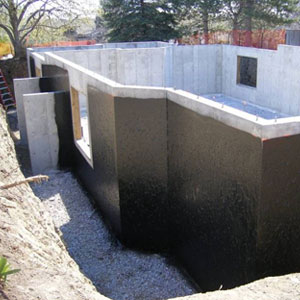
Resources
- Home
- Cheap Waterproof Walls
- How to Waterproof Basement Walls
- How to Waterproof Walls
- Waterproof Baesment Walls
- Waterproof Basement Walls
- Waterproof Bathroom Walls
- Waterproof Brick Walls
- Waterproof Concrete Walls
- Waterproof Exterior Walls
- Waterproof Foundation Walls
- Waterproof Garage Walls
- Waterproof Kitchen Walls
- Waterproof Wall Paint
- Waterproof Wall Panels
- Waterproof Walls Coating
- Waterproof Walls Companies
- Waterproof Walls Covering
- Waterproof Walls DIY
- Waterproof Walls FAQs
- Waterproof Walls Prices
Waterproof Concrete Walls
More than 50% of homes with basements have problems with sweating and moisture. The reason so many homes have this problem is because most basements feature concrete walls. Without any treatment, the porous nature of concrete walls means they're a prime location for moisture accumulation. This problem can be solved by waterproofing them. Waterproofing concrete walls will eliminate sweating. Because waterproofing will prevent moisture from accumulating, you won't have to worry about mold growth.
Features of Waterproof Concrete Sealant
Sealant doesn't contain any harsh chemicals. This makes it safe to use on indoor concrete walls like those in your basement. Once you've applied sealant to concrete walls, it will be easier than ever to keep them clean. Because moisture accumulation does take a toll on concrete, using this type of sealant will keep your concrete walls in good shape for longer. It's also important to acknowledge the significance of preventing mold growth. Since it can cost thousands of dollars to take care of a mold problem, investing in waterproof sealant can help you save a significant amount of money.
Is Waterproof Sealant Right for Your Concrete Walls?
If you want to prevent mold from growing in your basement or any other room in your home where there are concrete walls, waterproof sealant is the best option. Using a sealant to waterproof concrete walls is very affordable. Because you only have to go through the sealing process one time, you will get a lot of value for your money. It's also very easy to apply sealant. You can use a sprayer or brush to complete the job in less time without sacrificing quality. Sealant can also be applied to concrete that's wet or damp. Even if you already have a moisture problem, it's not too late to solve it with sealant.
Some homeowners are concerned that the sealant they apply is going to start wearing off. In reality, the bond between the concrete walls and the waterproof sealant will actually get stronger as time goes on. Not only is sealant designed to last a lifetime, but it has the ability to withstand large amounts of hydrostatic pressure. Waterproof concrete sealant is capable of filling many cracks. If there are very large cracks in your concrete walls, you can easily take care of them prior to waterproofing by using crack filler.
How to Use Waterproof Sealant
The main steps you need to follow to use sealant to waterproof concrete walls are:
- Clearing off the walls' surface
- Thoroughly cleaning the walls
- Mixing the sealant
- Applying the first coat
- Promptly applying the second coat
- Periodically misting the walls' surface for approximately 3 days to fully set the sealant
The reason it's so important to clear anything off the walls and then thoroughly clean them is failing to do so would weaken the sealant's bond with the concrete. All you'll need to use when mixing the sealant is the powder and water. And once you're done applying the sealant, periodically misting it will ensure the sealant seeps all the way down into the concrete walls.
